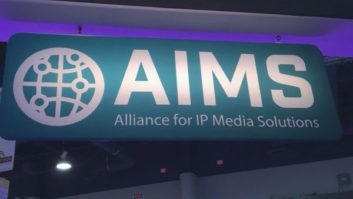While the many signs of convergence between broadcast and pro AV now constitute a dominant topic of conversation in both industries, the extent to which technical standardisation has advanced still continues to be an important point of distinction. So whereas the advent of new networking and connectivity technologies has generally been accompanied by some degree of standardisation in broadcast, the situation in the pro AV market has often been more diffuse, especially since the mass-adoption of IP got underway.
In which context, it’s not hard to understand why the IPMX (Internet Protocol Media Experience) project – which applies standards and open specifications to enable the transportation of compressed and uncompressed video, audio and data over IP networks for the pro AV market – appears to resonate so strongly with vendors, integrators and end-users.

STRONG FOUNDATIONS
The IPMX project was created in 2020 by AIMS (Alliance for IP Media Solutions), which remains one of its key proponents. It builds on foundational work from three other leading industry organisations: SMPTE, VSF and AMWA. As a result, already established and well-recognised standards and specifications, including some of AMWA’s NMOS (Networked Media Open Specifications), are integrated into IPMX, ensuring that pro AV users can have confidence in the robustness of the underlying technologies from day one.
With IPMX now generating strong buzz in several pro AV verticals – notably, corporate and education – this article takes a look at the inspiration for, and evolution of, IPMX, the contribution made by NMOS to IPMX, and its exciting potential in the key vertical of education.
PRO AV PROVISIONS
Whilst drawing on existing standards and specifications developed with broadcast as the primary focus, IPMX adds a number of capabilities that ensure it can be relevant to the full range of pro AV applications. Those extra provisions include asynchronous audio and video support; 4K60 transmission over a single Gigabit network; high-bandwidth Digital Content Protection (HDCP) for the safeguarding of copyrighted content during transportation, for example from a device to a display; and measures that simplify connection management.
Developed to enable easier configuration and operation of networked media environments, the NMOS specifications provide – to quote the IPMX website – “the ‘plug and play’ capabilities needed to easily add and integrate devices in an IP media workflow”. As a result, some aspects of transporting the media can be automated, albeit on a permissions basis to ensure cybersecurity protection, whilst IPMX’s flexibility to be implemented in hardware and software is beneficial for the increasingly commonplace hybrid deployments encountered in corporate applications such as conferencing.
IPMX also draws on the SMPTE ST 2110 standards for media transport, which now underpin the infrastructure of countless IP and hybrid IP/SDI broadcast centres and outside broadcast trucks around the world, as well as an increasing number of conference centres and other high-end AV environments. Then, from VSF, come extensions such as relaxed timing and the aforementioned HDCP that are widely needed in AV.
With 2024 bringing the news that the key IPMX documents had been finalised after an extensive testing process headed by the VSF and involving multiple manufacturers, AIMS said that the milestone represented a “new era of innovation and interoperability” in the pro AV market.
IP BRIDGE
Samuel Recine is the chairperson of the Pro AV Working Group for AIMS, and vice president, global strategic partnerships at Matrox Video. As well as being a supporter of open standards, including IPMX, Matrox was an early adopter of NMOS in solutions such as the Matrox ConductIP Media Routing Appliance & Software, which allow users to discover, route and monitor any NMOS-enabled ST 2110 or IPMX-ready open standards device.
Recine argues that prior to 2020 it was apparent that different classes of equipment had started their migration differently, which meant there were a many different AVoP implementations. He says: “The only way to bridge those assets was to go back to the baseband connections, which eliminates a big part of the benefit of moving to AVoIP in the first place.”
Having gone through the rigours of creating an SDI-to-IP migration path in broadcast, a starting point existed for further work that would allow wider application in pro AV. ST 2110 was selected to provide the basis of the media transportation because it is designed for scale and is suitable for big networks. Recine observes: “Not only can it support big networks of products, it can even support synchronisation of all those products at scale.”
With all of the core technologies selected, work commenced on extensions that would ultimately allow more users, principally in pro AV and PC/IT, to leverage the widened ST 2110 standards in many new workflows and deal with the problem of connecting assets from different classes without regressing to baseband signals to do so.
BRIGHTER FUTURE
Speaking at the time of the key document finalisation, Recine says: “IPMX can now be implemented by many existing developers of ST 2110 products, but is also completely new and indigenous to pro AV and PC/IT developers, which is what is needed for a robust, open AVoIP ecosystem.”
Among the experts welcoming the advance of IPMX is Doug Savoie, AV system designer/installer at the University of Alberta in Canada. In both academic and practical senses, he has been involved in pro AV for more than 30 years and believes that the fundamental approach of the IPMX project means it is destined for great things.
“The big reason why I think it’s going to help is that IPMX is an open standard that can simplify hookups for installation and maintenance,” says Savoie. From a vendor perspective, he believes it is going to move the industry’s network capabilities forward more quickly than proprietary methods could.
EDUCATIONAL ADVANTAGES
He also perceives specific benefits for education as technological flexibility becomes essential to everyday learning. He comments: “A lot of courses are going hybrid now, which means there are often a certain number of students in the classroom and a certain number who are participating remotely. There is definitely a role for the IPMX standards in allowing you to integrate activities inside and outside the classroom more effectively.”
There is also an impetus for universities to implement robust new technologies, invariably underpinned by solid IP infrastructures, if they are to remain competitive. “Students are going to drive how education moves forward more than many educators think,” says Savoie. “So if a university does not have the options, equipment or capabilities that a student wants, they wil go elsewhere.”
All the more reason to welcome IPMX, which – backed by NMOS and the other essential technologies – is now poised to transform IP networking in so many verticals. Concludes Savoie: “After so many years of [competing approaches], the future of everything in this area is now looking much brighter to me.”







